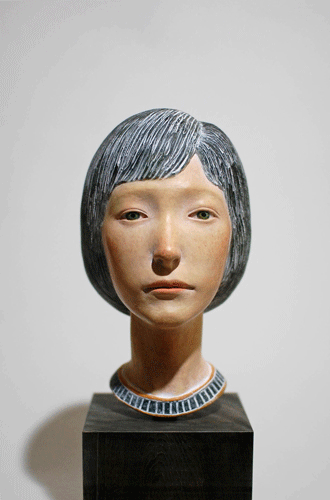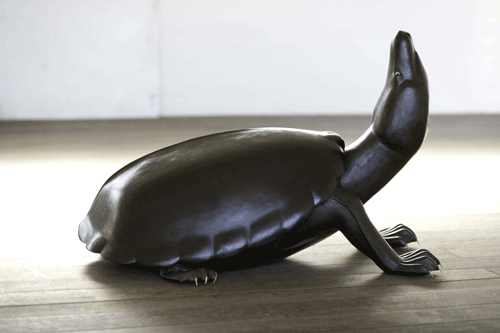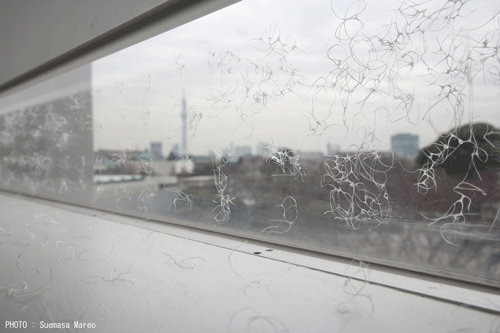
ネオ・ブッディズム Neo Buddhism
Artists :Yuhei Kameshima, Yuko Kobayashi, Yusuke Tsuchiya, Mai Yokoyama
Curation by Maya Karasawa
2011. 4. 23 Sat - 5. 28 Sat
Tue - Sat 12pm -7pm /closed on Sun, Mon, Public Holiday
Vernissage : on Saturday, 23rd April 6pm - 8pm
KIDO Press is pleased to announce an exhibition of works by four artists who were selected for their fresh esthetics by one of the young curators,
Maya Karasawa, who is blazing the path to tomorrow's art.These promising young artists deal in sculpture, painting, installations, and other media,
and their future activities merit close attention. Each
f
reely creates a world that is all his or her own in the chosen medium.
TSUCHIYA Yusuke

title : I don’t forget the transparency.
material : terracotta
size: H23×W13×D15cm
year : 2010
(c)Yusuke Tsuchiya
The sculptures of Yusuke Tsuchiya were a major factor behind the inspiration for this exhibition. Although he is averse to talking extensively about his own productions, he furnishes them with titles that leave clues for their interpretation. I consider the titles to be poems that are even more succinct than haiku.
With slender terra-cotta bodies and limbs, Tsuchiya's works look as ephemeral and fragile as pieces of spun candy on first glance. The assiduous craftsmanship manifested in everything down to the smallest details also conveys a certain toughness and intensity. This impression calls to mind another work of art: the 8th-century Ashura statue in Nara's Kofukuji Temple. Tsuchiya's works may conceivably be viewed as contemporary Buddhist sculptures.
Biography
1985 Born in Chiba, Japan
2009 BFA, Sculpture, Tokyo University of the Arts
2011 MFA, Sculpture, Tokyo University of the Arts
2011 “The 4th Le chat qui parle” Sakura City Museum Of Art, Chiba, Japan
“The 59th Tokyo University of the Arts The graduation Works Exhibition”Tokyo
University of the Arts
2010 “The 3rd Le chat qui parle”Sakura City Museum Of Art, Chiba, Japan
[Solo Exhibition] “-dreamer-” Gallery SEIHO, Tokyo
“Vision” Gallery NAMIKI, Tokyo
2009 “ART AWARD TOKYO MARUNOUCHI 2009”Tokyo station, Gyoko-dori Underground Gallery
“The real me in art and art in me”KARASAWA clinic, Tokyo
[Solo Exhibition] “ -your world-”Gallery UMI, Chiba, Japan
“The town of time and space -The sounds of town-”TEPUKO Asakusa pavilion, Tokyo
KAMESHIMA Tuhei

title : draw a breath
material:
Japanese lacquer (urusi), line, glass sand (tonoko), fossil fang
size :H58.5×W55×D90cm
year : 2011
(c)Yuhei Kameshima
The Ashura statue was made by the dry-lacquer process, which is also employed by Yuhei Kameshima in his artistic production.
With a keen interest in animal motifs, Kameshima used to make three-dimensional pieces in the nature of impromptu figurines that are both kitsch and colorful. Over the last year, however, he has accomplished a remarkable transformation. His incorporation of the dry-lacquer technique has lengthened the production process and thereby given him precious time for pursuit of form. As a result, his molding has become more refined, and his recent works are endowed with tension and sinew that were absent before.
I urge all art lovers to drop by the show and see his evolution as an artist with your own eyes.
Biography
1988 Born in Fukuoka, Japan
2011 BFA, in Sculpture, Musashino Art University
Now Studied at Sculpture, Graduate School, Musashino Art University
2011“ Art site Iwamuro Onsen 2011”Nigata, Japan
“Joint Graduation Exhibition of 5 Art Universities in Tokyo”The National Art Center Tokyo
Exellent Prize at“Musasino Art University Degree Show 2011”, Tokyo
2010 “ITSUDATU” Musasino Art University, Tokyo
2009 “Kodaira Art Site 09” Musasino Art University, Tokyo
2008 “GEISAI #11”Tokyo Big Site
KOBAYASHI Yuko
 title : Floating indecision
title : Floating indecision
material:silver Hill Kent
size:no fix
year:2010
(c)Yuko Kobayashi
The graceful curves of the works created by Yuko Kobayashi resemble veins of leaves or clumps of yarn. They are, in fact, made of cut strips of paper and plant parts. Her almost perversely careful attention to the ornamental particulars even emanates a certain spirituality.
To my mind, it echoes the mentality of Kaikei, a sculptor-monk of the Kamakura Period (1185 - 1333), in his frequent application of "kirigane" snips of gold leaf over the entire surface of his statues. If Kaikei showed his feeling of reverence toward the Buddha by applying this incredibly tedious process, I would submit that Kobayashi, who has an abiding interest in natural science, is in the same way striving to display her reverence for nature with her use of lines like the veins of leaves.
Biography
1981 Born in Tokyo
2003 BA, in The department of Information Studying, Tokyo Gakugei University School of Education
2011 BFA, in Oil Painting, Tokyo University of the Arts
Now Studied at Oil Painting, Graduate School, Tokyo University of the Arts
2011 “The 59th Tokyo University of the Arts The graduation Works Exhibition”Tokyo University of the Arts
2010 “ HOYA NO IE”Phallus-Kan, Tokyo
2009 “ Regreen Arts ! 2009 - To Windy Valley -” Regreen Base, Yamanashi, Japan
“ HOME” NICO CAFE, Tokyo
2008 [Solo Exhibition]“ gradual erosion ”youkobo ART SAPCE, Tokyo
2007 “ THE SIX”Yokohama Red Brick Warehouse, Kanagawa, Japan
YOKOYAMA Mai
 title : FATAL ERROR
title : FATAL ERROR
material : acrylic color ink, oil pastel, water soluble pastel
size:51.5 ×36.4 cm
year:2010
(c)Mai Yokoyama
The paintings of Mai Yokoyama, who obsessively draws little rings that spill over the whole canvas, call to mind outsider art. But when I actually met her, she impressed me as an ordinary university student. "I make paintings so I can be kind in my dealings with people," she says. "Artistic production is the same thing as exhalation. You get all the bad stuff out on the canvas, so you can be nice with people in person."
I nevertheless believe that she paints to leave behind works as testaments not when she is struggling with difficulties but when she has overcome them. This is why her paintings do not make one feel struggle and pain; on the contrary, they seem to encourage viewers, to tell them "you, too, will be okay." Her approach of flooding the canvas with her motifs as if utterly heedless of composition approximates that of a child, and is similarly brimming with boldness and an unsinkable buoyancy.
Biography
1989 Born in Kanagawa, Japan
2009 Entered Oil Painting, Tokyo University of the Arts
Now Studied at Oil Painting, Tokyo University of the Arts
2011 “Exhibition for promotion”Tokyo University of the Arts
2010 “JOBAN ART UMBRELLA in Kitasenjyu” Ibaraki, Japan
HYAKUNOREN post card rally project, Ibaraki, Japan
“Entrance Fee - drawings by emerging artists” Art Market WHOLE, Tokyo
2009 “Toride Art Path 2009”Tokyo University of the Arts
“GEISAI#14” Tokyo Big Site
Cycle Art Festival 2009,Ibaraki, Japan
<About the exhibition>
The works of young artists (mainly in their 20s) are often characterized as "lacking a sense of reality", "empty", or "superficial". Alternatively, they are apt to be regarded as the product of the artist's personal experience or sensibility. These perspectives somehow trail negative connotations.
Belonging to the same generation as these artists, I myself am put off by this outlook. I realize that artists in their 20s undoubtedly do not want to hear words of mere sympathy, but I would like to talk about their works in positive language anyway.
It was out of this desire that I hit upon the title of this exhibition: "Neo Buddhism".
Are their works really that feeble? And are works of auto-allusion inferior as art? Turning such questions over in my mind, it occurred to me that "lack of reality" and the other stereotypical comments about the works of artists in their 20s may also be applied to Buddhist art to a certain degree. This is because Buddhist art frequently and boldly resorts to depictions completely divorced from reality in order to conjure up the magnificence of the Buddha's cosmos. Similarly, the works of young artists also have something in common with Buddhist art in respect of the silent power immanent in them and the almost maniacal meticulousness about the finest details.
Historically, the Japanese attempted to make their wishes for the recovery of their sick relatives and the sound growth of their children come true by offering prayers to Buddhist pictures and statues. As such, in today's world, when such practices are rare, the treatment of self-alluding themes by Japanese artists could be construed as an act for the purpose of producing objects of devotion for the viewers, through artistic creation. Perhaps they are giving birth to a new form of Buddhist art! This insight led to my coinage of the term "Neo Buddhism".
When these artists confronted the communication tool that is art with an earnest attitude, the theme of their works became recursive. They produce works with solid expertise and rigorous particularity extending to the finest points. This prevents their creations from becoming autobiographical and endows them with even more strength.
The Neo Buddhism exhibition promises to be a venue where visitors can encounter the quiet passion of four young artists.
written by Maya Karasawa (KARAKURI project)
KARASAWA Maya (curator)
1989 Born in Tokyo
2011 BFA, in Aesthetic and Art History, Tokyo University of the Arts
2010 Text;“GLOBAL NEW ART” Curated and supervised by Nobuyuki Hiromoto, Bijutsu
Shuppan-Sha Co., Ltd., 2010
-Ataka Prize
2009 Curation; “The real me in art and art in me”KARASAWA clinic, Tokyo
Study; “A Method of Education for the Appreciation of Fine Arts, in Which Viewing andCreating Works of Art are Unified”
,at Kichijo Girls Junior and Senior High School,supported by Panasonic Education Foundation
2008 Gallery Talk; “ THE SIX 08”
2007 Organized an Art Project, “Karakuri Project”